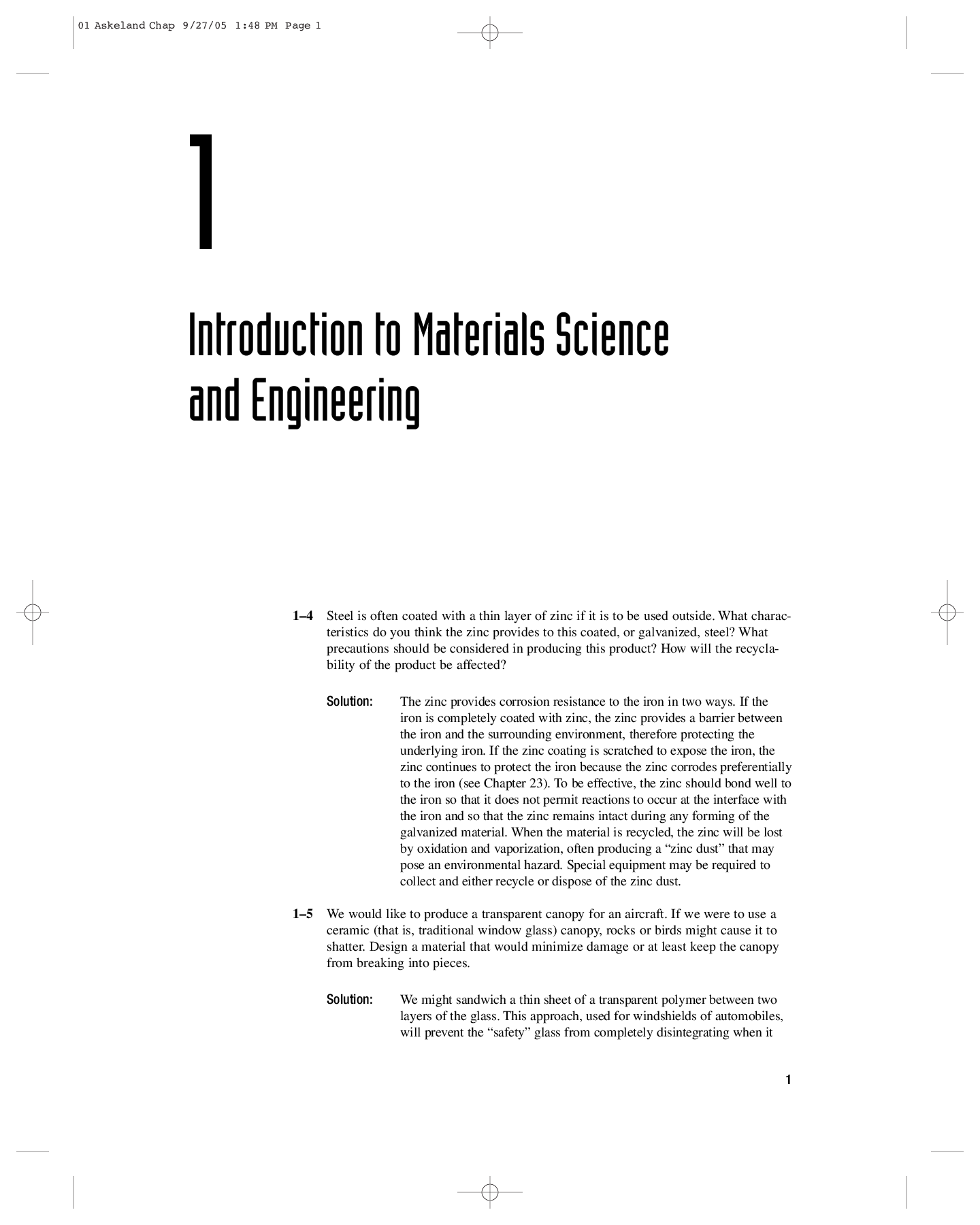1–4 Steel is often coated with a thin layer of zinc if it is to be used outside. What characteristics do you think the zinc provides to this coated, or galvanized, steel? What
precautions should be considered in producing this product? How will the recyclability of the product be affected?
Solution: The zinc provides corrosion resistance to the iron in two ways. If the
iron is completely coated with zinc, the zinc provides a barrier between
the iron and the surrounding environment, therefore protecting the
underlying iron. If the zinc coating is scratched to expose the iron, the
zinc continues to protect the iron because the zinc corrodes preferentially
to the iron (see Chapter 23). To be effective, the zinc should bond well to
the iron so that it does not permit reactions to occur at the interface with
the iron and so that the zinc remains intact during any forming of the
galvanized material. When the material is recycled, the zinc will be lost
by oxidation and vaporization, often producing a “zinc dust” that may
pose an environmental hazard. Special equipment may be required to
collect and either recycle or dispose of the zinc dust.
1–5 We would like to produce a transparent canopy for an aircraft. If we were to use a
ceramic (that is, traditional window glass) canopy, rocks or birds might cause it to
shatter. Design a material that would minimize damage or at least keep the canopy
from breaking into pieces.
Solution: We might sandwich a thin sheet of a transparent polymer between two
layers of the glass. This approach, used for windshields of automobiles,
will prevent the “safety” glass from completely disintegrating when it
01 Askeland Chap 9/27/05 1:48 PM Page 1
fails, with the polymer holding the broken pieces of glass together until
the canopy can be replaced.
Another approach might be to use a transparent, “glassy” polymer
material such as polycarbonate. Some polymers have reasonably good
impact properties and may resist failure. The polymers can also be
toughened to resist impact by introducing tiny globules of a rubber,
or elastomer, into the polymer; these globules improve the
energy-absorbing ability of the composite polymer, while being too
small to interfere with the optical properties of the material.
1–6 Coiled springs ought to be very strong and stiff. Si3N4 is a strong, stiff material.
Would you select this material for a spring? Explain.
Solution: Springs are intended to resist high elastic forces, where only the atomic
bonds are stretched when the force is applied. The silicon nitride would
satisfy this requirement. However, we would like to also have good
resistance to impact and at least some ductility (in case the spring is
overloaded) to assure that the spring will not fail catastrophically. We
also would like to be sure that all springs will perform satisfactorily.
Ceramic materials such as silicon nitride have virtually no ductility,
poor impact properties, and often are difficult to manufacture without
introducing at least some small flaws that cause to fail even for relatively
low forces. The silicon nitride is NOT recommended.
1–7 Temperature indicators are sometimes produced from a coiled metal strip that
uncoils a specific amount when the temperature increases. How does this work;
from what kind of material would the indicator be made; and what are the important
properties that the material in the indicator must possess?
Solution: Bimetallic materials are produced by bonding two materials having
different coefficients of thermal expansion to one another, forming a
laminar composite. When the temperature changes, one of the materials
will expand or contract more than the other material. This difference in
expansion or contraction causes the bimetallic material to change shape;
if the original shape is that of a coil, then the device will coil or uncoil,
depending on the direction of the temperature change. In order for the
material to perform well, the two materials must have very different
coefficients of thermal expansion and should have high enough modulus
of elasticity so that no permanent deformation of the material occurs.
1–8 You would like to design an aircraft that can be flown by human power nonstop for
a distance of 30 km. What types of material properties would you recommend?
What materials might be appropriate?
Solution: Such an aircraft must possess enough strength and stiffness to resist
its own weight, the weight of the human “power source”, and any
aerodynamic forces imposed on it. On the other hand, it must be as light
as possible to assure that the human can generate enough work to
operate the aircraft. Composite materials, particularly those based on a
polymer matrix, might comprise the bulk of the aircraft. The polymers
have a light weight (with densities of less than half that of aluminum)
and can be strengthened by introducing strong, stiff fibers made of glass,
carbon, or other polymers. Composites having the strength and stiffness
Read More


